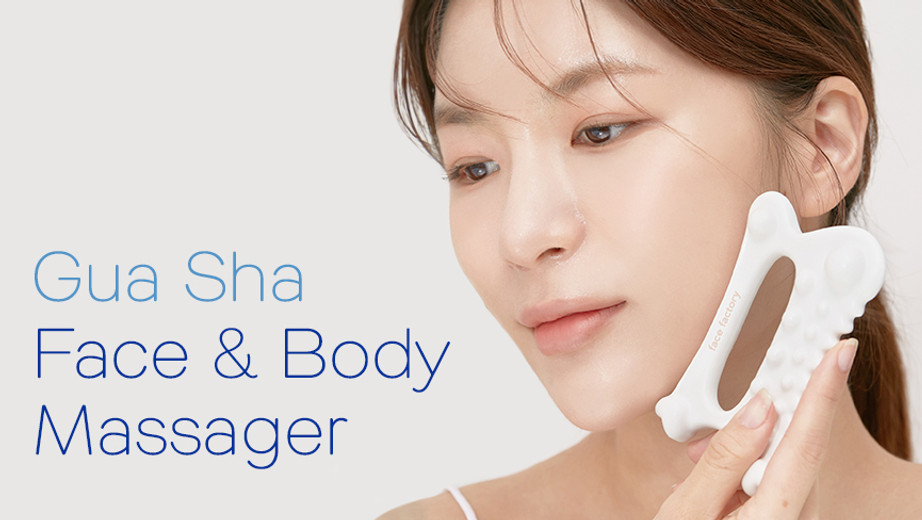How to Use the Ceramic Gua Sha Face & Body Massager for Tension Relief
Posted by Kris Washington-Carroll on Jan 11th 2023
What is Gua Sha?
Gua sha is a health technique from Traditional Chinese Medicine (TCM) that involves “scraping” the face and body with a specialized tool. You may have heard of facial gua sha, which many people use to promote a healthy, youthful appearance. But as you’ll learn in this article, gua sha is for more than just your face, and the benefits go way beyond enhancing your beauty. According to TCM and other East Asian energy practices, stroking the skin with a gua sha tool can promote detoxification, relaxation of tight muscles and tissues, and energy circulation that encourages healing on many levels.
Traditionally, the most common symptoms treated with gua sha include:
- shoulder and neck tension
- back pain
- tennis elbow
- carpal tunnel syndrome
- poor circulation
- scar tissue
- facial puffiness, bags and wrinkles
What Does “Gua Sha” Mean?
In the direct translation of the Chinese, “刮 (gua)” means “scrape” and “痧 (sha)” means “sand”. While the sand that you see on the beach is written as 沙, the sand in gua sha has an extra part over it which gives it a medical meaning. This “痧 (sha)” sand refers to the tiny speckled bruising that can appear on the skin after treatment.
Some people translate 痧 (sha) as a blockage in the body. According to traditional East Asian medicine, energy (known as qi, chi, or ki) is meant to run freely and in a balanced way throughout our bodies. If there is a blockage of energy, or blood or lymph stagnation, pain or illness arises. So gua sha is the way we get the blockage to come out from hiding so it can heal. Gua sha is said to disperse stagnant blood and energy, thereby reactivating the natural state of health.
If you give gua sha a try, don’t be alarmed if you experience some light bruising — it should only last up to 7 days at most, and will not be painful or sensitive if done correctly. In many cases, gua sha doesn’t leave any marks at all, especially if you use a light touch. Facial gua sha should not produce any marks.
Is Gua Sha Proven by Science?
Multiple scientific studies have proven the effectiveness of gua sha for various ailments:
A 2014 study found that gua sha reduced neck and shoulder pain and improved the range of motion in a group of people who used computers frequently, in comparison with a control group that received no treatment…
A 2017 study showed that older adults with chronic low back pain who were treated with gua sha had longer-lasting symptom-relief than those who were treated with a hot pack…
And other studies have also shown that gua sha may reduce chronic pain, speed muscle recovery in athletes, balance women’s hormone levels, and promote healing of conditions such as peripheral neuropathy (dysfunction in the part of the nervous system that delivers messages to the brain).
How to Do Gua Sha
Gua sha is simple and easy to do. Just be sure to listen to your body and use the amount of pressure that feels right. Remember, light specks of bruising on areas other than the face are normal and should go away within a week. They should not be painful. Speak with your healthcare provider to be sure that a gua sha routine is appropriate for your condition.
Gua sha can be done on the face as well as most areas of the body including neck and shoulders, arms, legs, abdomen and buttocks. It can be done on bare skin, but many people find it more effective to lubricate first with cream, lotion or body oils.
It’s typically performed along the meridians, the channels through which ki energy flows, according to East Asian wisdom. You scrape across the skin using long strokes and a fair amount of pressure to move stagnant blood, lymph and energy.
You can work on areas of pain or on specific meridian lines, or simply do an all-around routine.
The Ceramic Gua Sha Face & Body Massager
Gua sha is sometimes also referred to as “spooning” or “coining”, because historically it was done using a ceramic soup spoon or a well-worn coin. Today, it is common to find gua sha tools made out of polished materials like jade, quartz, or bone. Our Ceramic Gua Sha Face & Body Massager offers a superior design; it’s based on tradition but enhanced by biomedical engineers to include 7 different angles for different usages… so you get maximum benefit throughout the body without tiring your hands.
Here are some examples of how to use the different angles of our innovative Ceramic Gua Sha Face & Body Massager:
1. Cheeks & Sides of Face: Massage the cheeks and sides of nose and mouth by sweeping from the nostrils toward the ear to release tension and move lymph.
2. Shoulders, Neck & Clavicle: Put the curve of the narrow U zone over the rounded body part and massage both sides with acupressure. Apply gentle pressure to the back of the hairline and massage down the neck.
3. Jawline: Sweep up from the chin toward the ear, around the jaw and lower cheek.
4. Scalp: Comb and massage scalp with firm pressure.
The main point of the gua sha tool is to stimulate acupressure points throughout the body and release tension to move lymph. Apart from the areas mentioned above, you can use this tool on your legs, arms, hands, feet, and acupressure points all over the body.
For the best results, practice facial gua sha regularly, such as once or twice a week. For the body, do your gua sha treatment as needed.
Check out our Ceramic Gua Sha Face & Body Massager here.


